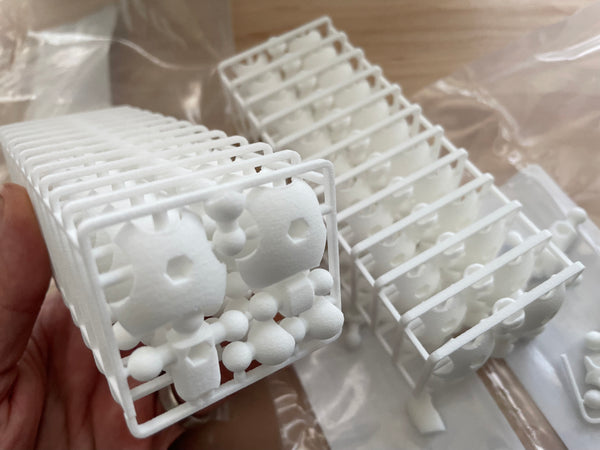
Behind the scenes: Unboxing 3d printed product sets for restock
People seem to wonder how the whole ModiBot thing works.
I get a lot of questions-
- Why do the materials feel different on different items?
- Which items are 3d printed?
- Which are not?
- Do you print them yourself?
- Can I print items in this same material?
- Why do some items run out of stock so quickly?
As I am restocking items, I figured I'd do my own unboxing and tell you a bit about how ModiBot utilizes 3d printing to bring you items that normally wouldn't be available.
Using 3D print services
ModiBot was initially designed and prototyped using 3d printing. I launched the first system parts, which looked very different, on Shapeways.com around October of 2011. I use a combination of Shapeways, Sculpteo, and iMaterialise to manufacture my small batch sets of nearly all of my kits.
Fun fact! Only the Mo figure and Venture accessory set are injection molded like traditional products you buy in the store

Package from Sculpteo.com containing a variety of kits.

Part sets come individually wrapped and labeled for easy sorting. This would be considered a 'larger than normal' order because of the recent increase in traffic.

The entire contents of the package laid out. You can see that sometimes loose parts come off the kits. This means that I need to do a bit more work to make sure the sets don't come apart during the clean-up and post-processing phase of the manufacturing process.

These are ModiBot Myke sets in a modified brick formation.
ModiBot kits are made using a 3d printing process called SLS printing. SLS stands for Selective Laser Sintering. Which means that these items are made by laser melting thin layers of plastic powder together, layer-by-layer, to create parts or frames as shown.
These kits are strung together using 'stringers' shown at the top and bottom. These stringers allow the parts to move back and forth which allows for easier removal of the excess powder.

This is a brick of Moli Deluxe kits in a 'hard' brick format which doesn't have a stringer, but still allows room for easy removal of excess powder. The Myke version of the stringer technique is newer and I will probably move most of the other kits to that format.

Above pic shows the Basic Moli kits. This is a different use of a 'loop stringer'. the parts are captured on the stringer like a key chain. The cool parts is that its all created at one time so the parts are magically printed already on the stringer.

These are bricks of the Mobility Torso. If you look closely, you can see the thin layers of melted powder that forms the entire shape. This material is a form of polyester, so is very durable and can be sanded, polished, dyed, and painted.

Bricks of the Armor set for Mo figures. The reason that the items come on frames like a model kit is to make them easier to handle and much cheaper than printing a bunch of loose parts that need to be sorted, counted, packaged. Creating frames requires constant improvement. This frame can sometimes trap extra powder in the thigh guards which needs to be wiped off during assembly. I have an alternate version that I am testing now. Some of you may already have received them.

Before packaging, I trim each of the single frames off the main brick using plastic snips. You can see the cut marks on many of the products you receive.

While making plastic creative kits is far from sustainable, 3d printing does reduce the amount of manufacturing waste vs. injection molding. You can see the small amount of waste generated when cutting the frames apart. The customer will also have some leftover waste after trimming the parts off the frame.
I try to reduce the amount of ModiBot garbage that goes into the waste stream/land fill. This is why I have very little packaging and ship items in recycled and recyclable shippers.

Basic Moli parts coming off the stringer. Again, showing the small amount of waste generated in the process. You can see how the torso and hip are held together by small ribs that can be trimmed before use. I recommend using plastic snips as shown above or cuticle scissors also work well.

ModiBot Myke frames. These are recently updated to change the ball size of the connector joints. The down side is that these are no longer compatible with Mo and Moli joints, but it has increased the range of motion and made it so the figure stays remains together after assembly. As you can see, he can allow for using some other ModiBot parts like hats, hand-held accessories and some pegged items.

Here is a stringer of 'collar' connectors that fit the profile on Mo's head, torso and hips. You can use them to add arms/legs or other socketed parts to more unusual parts of the body. One additional thing to note is that stringers also allow items to be dyed as one single part. So sometimes, if you order a black version of a kit, it will be soaked in that dye color, just like an Easter egg.
I hope this helps to answer some of your questions about ModiBot. Now you can tell people a little bit about why ModiBot is different and how it is using next-generation printing technology to design a whole new way of doing business. Like many digital brands, ModiBot is a work-in-progress and always evolving its products and approach.
Thanks for all the interest and continued support!
Quick links
Search
FAQ
Terms of Service
Privacy Policy
Shipping Policy
Refund Policy

Leave a comment: